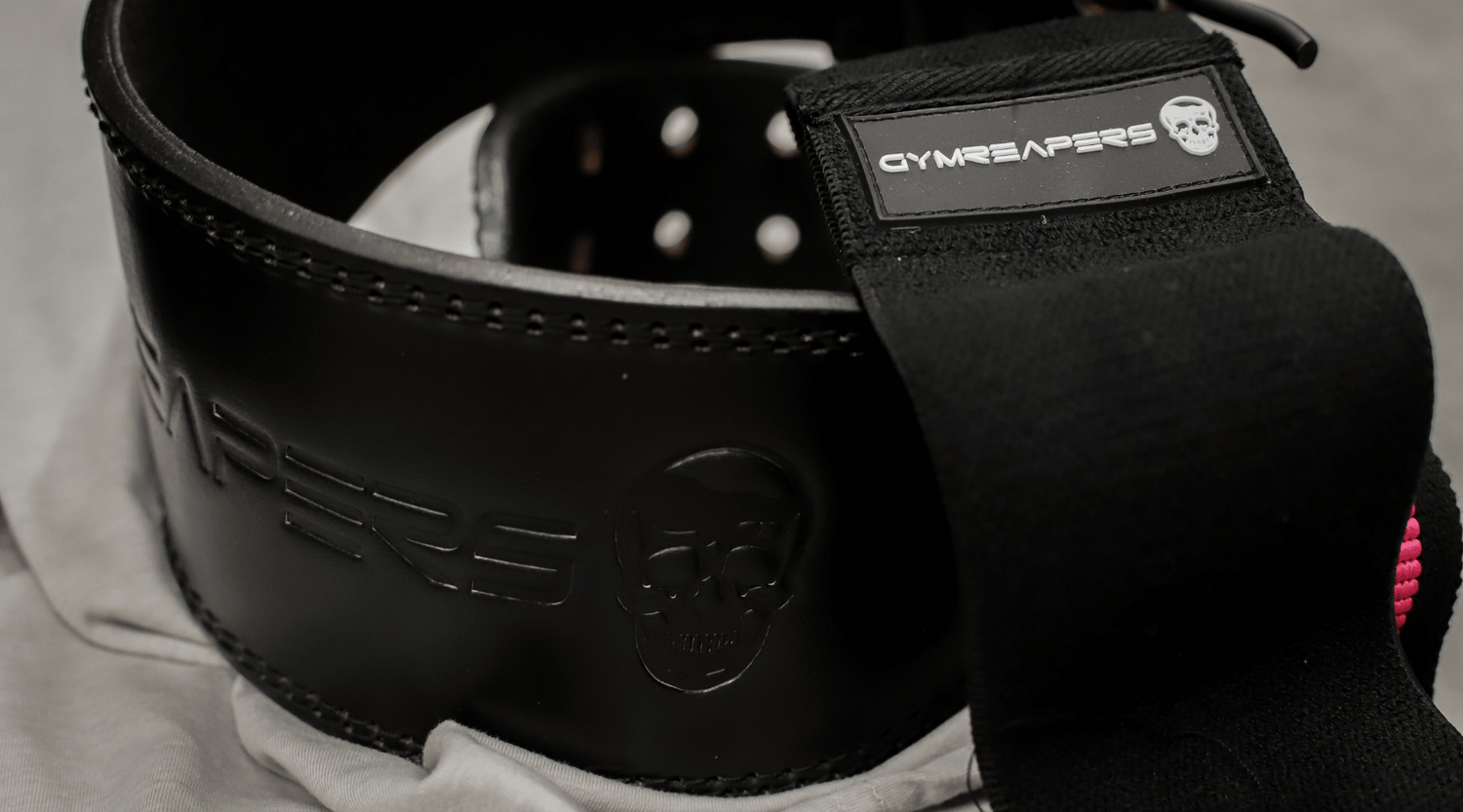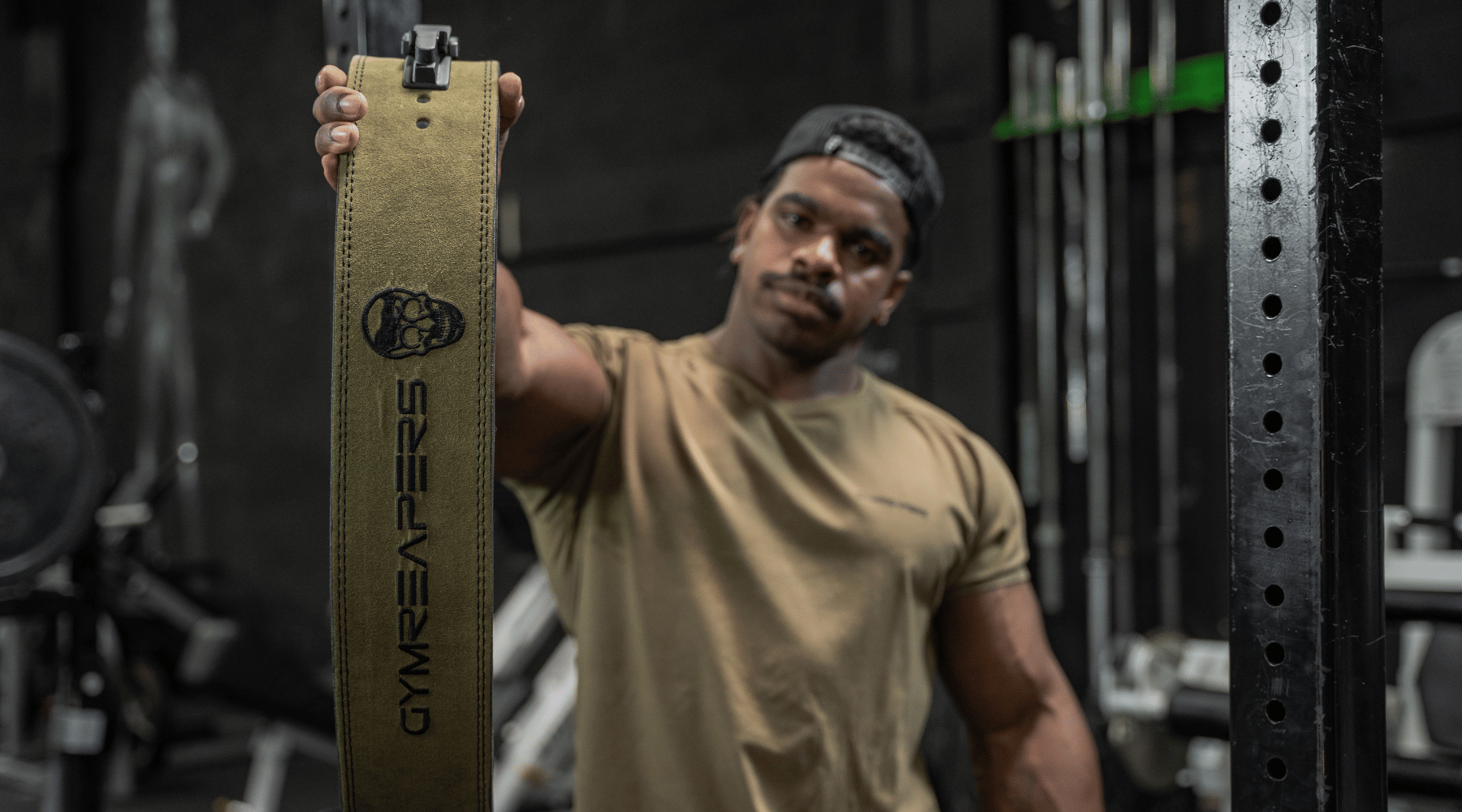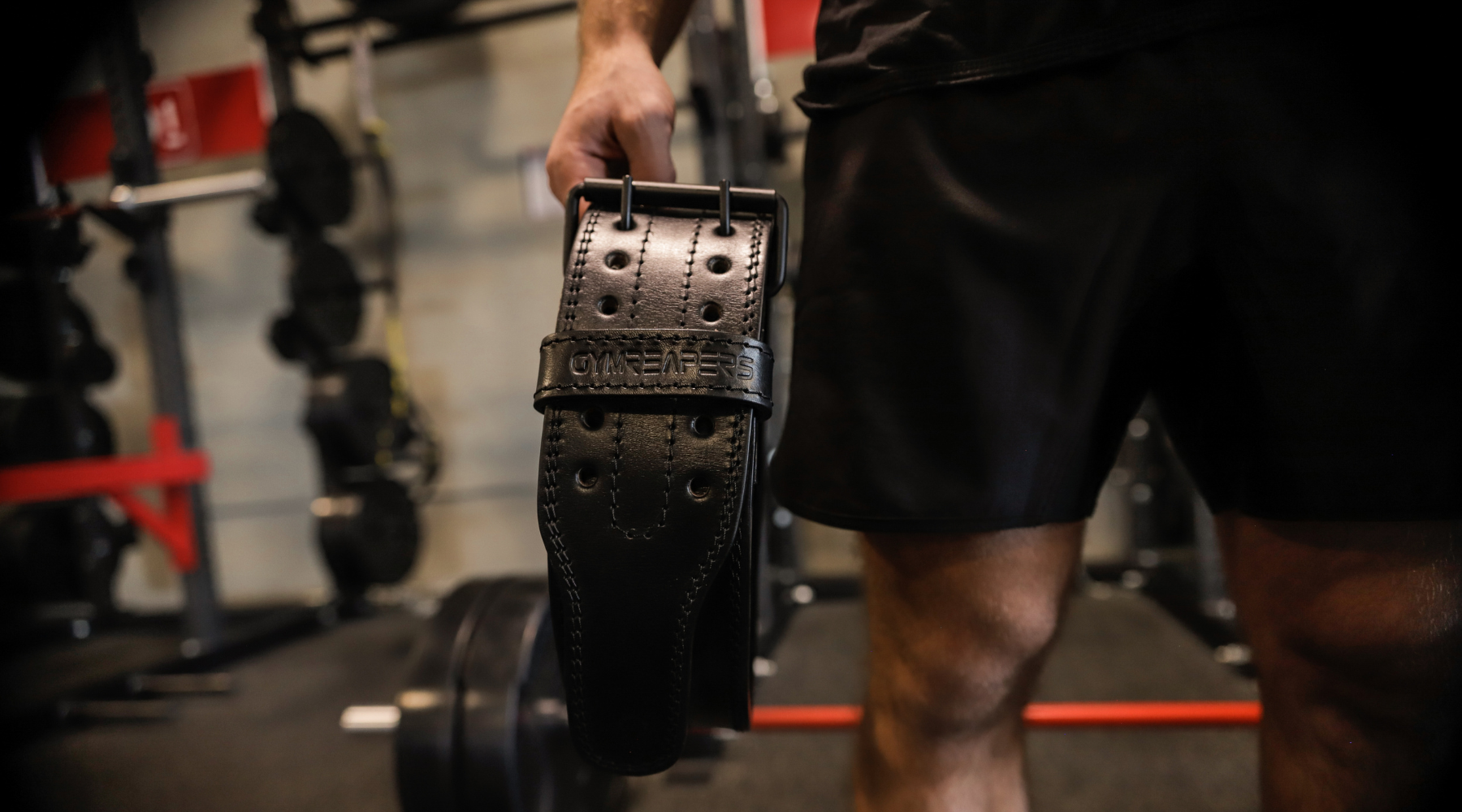Leather and nylon lifting belts are the two most popular materials people can choose between.
The main difference between leather and nylon belts is that leather belts offer more support, especially when worn for heavy compound exercises. Nylon belts tend to be less expensive and offer versatility and unrestricted movement while performing dynamic exercises like Olympic lifts or various Crossfit movements.
Below I’ll cover the pros, cons, and key differences between leather vs nylon lifting belts so you don’t end up wasting money on the wrong belt material.
What Is A Leather Belt?

Leather belts offer a high level of support and are primarily used for heavier training (i.e. lifts above 80% of your 1 rep max). Leather belts come in a variety of thicknesses, with the most popular options being 10mm and 13mm. They also come in both straight or tapered widths, as well as different fasteners, either prong or lever mechanisms.
Leather belts are great for lifters who want to push their max lifts, especially in heavy compound movements like squats, deadlifts, rows, and presses. They’re also ideal for competitive powerlifters, strongmen, and in some cases, Olympic weightlifters (so long as the belt is tapered, i.e. wider in the back and narrower in the front).
What Is A Nylon Belt?
A nylon belt offers a decent level of support (not as much as leather belts), but where they shine is with their versatility, since they can be used for numerous exercises. Nylon belts can come in a variety of styles (tapered or straight cut) and widths (most common being 3-5 inches). They also come in two fastening systems, velcro or ratchet.
Nylon belts are a popular choice among beginner or recreational lifters who want a belt for a variety of different movements but don’t have the aim to lift maximally, like a powerlifter. Nylon belts will still be advantageous for compound exercises like lunges and presses, but are more suited for dynamic exercises, like snatches, cleans, and kettlebell swings.
7 Differences Between Leather vs Nylon Belt
Below are seven main differences between leather and nylon belts.
1. Leather Belts Are More Expensive Than Nylon Belts
Leather is a more premium material than nylon, and also requires a metal fastener (either prong or level).
These belts can vary in price depending on the quality, thickness, and fastening system.
You should expect to spend $60-120 (or more) for a high-quality leather belt compared with a quality nylon belt, which typically costs $30-50.
2. Leather Belts Offer Greater Support Than Nylon Belts
For powerlifters, leather belts are the belt of choice, as they offer greater support for heavy lifts and come in 10mm and 13mm thickness options (which nylon belts do not).
Olympic lifters choose either leather or nylon, as tapered leather belts provide both support and comfort.
However, powerlifters are going to be lifting a lot more absolute weight than weightlifters, and therefore, will need the level of support that a leather belt provides. Plus, nylon belts aren’t approved for competition in a powerlifting meet.
Recreational lifters (non-competitive) typically choose either material or based on the other factors on this list.
3. Leather and Nylon Belts Have Different Fastening Mechanisms
Leather belts use a prong or lever fastening mechanism, whereas nylon belts use a velcro or velcro plus ratchet mechanism.
Depending on the level of security that you want, you may want to go with a prong or lever belt if you are looking for a belt that is more snug (rather than a velcro belt).
A nylon belt uses velcro or a combination of a velcro/ratchet mechanism, which offers good security (not as much as a lever or prong fastening mechanism) while also allowing you the ability to wear it looser on movements where you may only want light support.
4. Nylon Belts Are More Comfortable Than Leather
Out of the box (and even after you break in a leather belt), a nylon belt will be more comfortable. Nylon belts offer you the ability to not have to take off the belt between sets and adjust the fit as needed based on the exercise. The fit of the belt, especially the thickness, width, and taper also impacts overall comfort.
In some cases, nylon belts will offer a more comfortable fit, especially when performing movements that require high amounts of mobility (weightlifting or Crossfit movements).
It is important to note that sometimes the goal is not to be comfortable in a belt but to lift more weight and have the highest amount of support, in which case a leather belt would be a better option.
- Related Article: Are Lifting Belts Safe? Yes, Follow These 6 Rules Though
5. Nylon Belts Are Better Suited For Lifts That Require More Mobility

Nylon belts are better suited for lifts that require more mobility, such as dynamic exercises like snatches, cleans, kettlebell swings, lunges, etc. This of course can depend on the level of the lifter and the absolute loading, as some lifters still do choose to wear leather belts for these movements if they want added support.
Leather belts can be restricted due to their increased rigidity, and can limit the range of motion during movements where a lifter needs to move freely.
Some leather belts do come in a tapered fit (wide in the back and thinner in the front), which helps to address this issue, and provides the lifters with more support than a nylon belt, without overly restricting the mobility in dynamic lifts.
6. Nylon Belts Offer More Versatility
Nylon belts are more versatile leather belts and can be worn at varying levels of snugness and for different movements (both compound movements and dynamic exercises).
That said, choosing a more versatile belt may mean not getting the most amount of support you could when compared to leather. If support is your main goal, then you may want to go with a leather belt as it offers greater stability and structure for the lifts that matter to you.
7. Leather Belts Have a Longer Break-In Period
Leather belts have a longer break-in period than nylon belts.
Nylon belts have very little to no break-in period, whereas leather belts can take a few training sessions to find a more comfortable fit (as you break the leather in).
The reason nylon has less of a break-in period (or none at all), is that the belt material is simply more pliable.
Thicker leather belts, such as 13mm belts, may take even longer to break-in, and may never truly be “comfortable”. This, however, is a trade-off as thick leather belts offer the highest amount of support and rigidity.
Related Article: Olympic Lifting Belt Vs Powerlifting Belt: What Are the Differences?
What To Consider Before Buying A Leather or Nylon Belt

Below are some things to consider when deciding whether to buy a leather vs. nylon lifting belt.
Is this your first lifting belt?
If you are a first-time belt buyer, you most likely will do great with a quality nylon lifting belt. Nylon belts offer acceptable levels of support for a variety of and are easily adjustable, comfortable, and affordable.
The only exception to this is if you are specifically looking for a belt to wear for heavy squats and deadlifts, and are already lifting heavier loads without a belt.
Do you plan to wear it only for heavy compound lifts?
If you are planning to only wear a belt for heavy squats, deadlifts, presses, and rows, then you should go with a leather belt (10mm) as it offers more support than a nylon belt.
While a nylon belt can certainly be worn for these movements, leather belts do excel when it comes to offering support for heavy compound lifts.
Are You A Competitive Powerlifter or Plan To Compete In Powerlifting?
If you are a competitive powerlifter or plan to compete in powerlifting, a leather belt is superior to nylon. Leather belts offer you the highest amount of support and can be worn for all three competitive lifts (squat, bench press, and deadlift)
The most popular leather belt for powerlifting is a 10mm lifting belt.
Do you need a belt for Olympic lifts?
The Olympic lifts require a belt to provide support without restricting movement. A nylon belt is a great option for this, however so are leather belts that are tapered and not too thick.
Either style works well for Olympic lifts, and you’ll see elite-level lifters wearing both in competition based on preference.
Is price a key factor in your decision?
If price is a huge factor in your buying decision, go with a nylon belt, as they are less expensive than leather belts, and still offer good support and versatility.
Some brands do offer inexpensive leather belts, however, they tend to not last as long as quality belts. If you are looking for a quality, less expensive leather belt, take a look below at some of our belt recommendations.
Pros & Cons: Leather vs Nylon Belt

Leather Belt Pros
- Offers Excellent Support for Heavy Lifts
- Provides a Tight and Secure Fit
- Should Last You Decades.
Leather Belt Cons
- More Expensive
- Not Very Versatile
- Can Be Too Rigid for Some Lifts
Nylon Belt Pros
- Most Affordable Material
- Can Be Worn For a Variety of Movements
- Provides Support for Compound Lifts and Bodybuilding Movements
Nylon Belt Cons
- Velcro Can Become Weak
- Lacks Support for Very Heavy Lifting
- Difficult to Get A Very Tight Fit
Key Takeaways: Should You Get A Leather vs Nylon Belt?
Get a Leather Belt If:
If you have been lifting for a little while and want a belt to wear primarily for heavy compound exercises. I would recommend a prong-style over lever-style leather belt if you’re not a competitive athlete.
You also have a variety of options when it comes to leather belts, such as 10mm vs 13mm thickness belts (almost everyone should choose a 10mm unless you’ve previously worn a 10mm belt and are looking to upgrade).
If you are a high-level Olympic lifter looking for a more specialized lifting belt choose a tapered leather belt.
Get a Nylon Belt If:
If you are a beginner who has never worn a belt before and isn’t looking to max out your lifts but rather gain a bit of support across all movements. A nylon belt is affordable, versatile, and provides more than enough support for a beginner lifter.
If you want a nylon belt that provides the highest amount of support and a secure fit, look for a nylon belt that has a ratchet-style fastening system, which combines the powers of velcro and a metal ratchet to offer double security without impacting functionality.

Recommendations
Gymreapers Leather Belt
- Best Leather Belt for Heavy Compound Lifts and Powerlifters - 10mm Single Prong Belt
- Best Lever Belt for Powerlifters - 10mm Lever Belt
- Best Lever Belt for Elite Competitive Powerlifters - 13mm Single Lever Belt
- Best Olympic Lifting Leather Belt - 7mm Tapered Weightlifting Prong Belt
- Best Leather Belt on a Budget - 7mm Tapered Weightlifting Prong Belt
Gymreapers Nylon Belt
- Best Nylon Belt for General Fitness and Heavier Lifting - Quick Locking Weightlifting Belt
- Best Belt for Weighted Pull Ups and Dips - Nylon Dip Belt
Related: Want to learn more about belts? Check out the 7 different types of lifting belts and what they're used for.
Frequently Asked Questions
Are Nylon Lifting Belts Durable?
Yes, quality nylon lifting belts are very durable and are worn by lifters of all levels. They can be worn for heavy squats and deadlifts, Olympic lifts, and strongman movements.
While some lesser quality nylon belts can give out after a year or so of lifting, nylon belts that are made well can last years, especially when constructed with both a velcro and ratchet style fastening system.
Do Olympic Lifters Use Leather or Nylon Belts?
Olympic lifters will use both leather and nylon belts, as they both can provide great support and freedom to move without restrictions during full-depth squats, snatches, and cleans.
Some lifters prefer leather tapered belts, whereas others prefer a nylon belt with a ratchet-style fastener.













Leave a comment
All comments are moderated before being published.
This site is protected by hCaptcha and the hCaptcha Privacy Policy and Terms of Service apply.